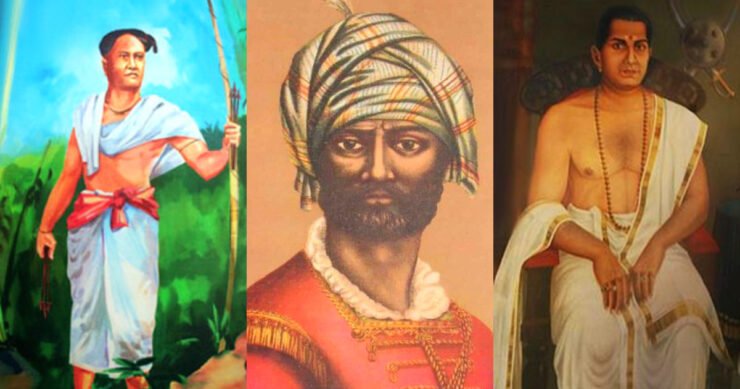
Thalakkal Chanthu was the commander-in-chief of the Kurichiya army of Pazhassi Raja. He led the fight against the British forces in the Wayanad forests in the first decade of the 19th century. He was an expert archer.
In the second half of the 18th century, most of the southern states in India were facing threats from Hyder Ali and his son Tipu, the rulers of Mysore. The East India Company supplied arms and ammunition to these states in their fight against Tipu. In return, the company was paid heavy taxes by the states. These taxes were collected by the officials in kind directly from the people. The Company’s main objective was to establish a monopoly over the pepper trade in the Malabar region. And it succeeded to a great extent.
The East India Company’s strategy was to annex the provinces as its vassals by fomenting civil unrest. However, the rulers of these south Indian provinces such as the Palayakkarars and the local chieftains of the present-day Tamil Nadu, never accepted the Company’s rules and bravely fought against it for decades. Veera Kerala Varma Pazhassi, the Raja of the Kottayam kingdom, provided support to the Palayakkarars and led the battle in the Malabar region.
Brave warriors
Thalakkal Chanthu was the general of the army of Pazhassi Raja. He belonged to the Kurichiya community, the brave warriors of the Wayanad forests famous for their archery skills. Chanthu along with his tribal brethren joined the force led by Edachena Kunkan to fight against the Company, which extorted a huge amount of grains as tax and resorted to land grabbing from the community.
The first resistance against the exploitation of the poor by the company was led by Edachena Kunkan in 1800. The continuous protest by the people was ignored by the Company leading to the attack on the Panamaram fort on October 11 in 1802. This fort served as the warehouse to store the granary collected from the people of the land as tax.
The whole battalion of the 4th Bombay Infantry comprising 70 soldiers under Captain Dickinson and Lieutenant Maxwell was killed by the army of 150 Kurichiya men led by Edachena Kunkan and Thalakkal Chanthu. The pistols and bayonets could not withstand the barrage of arrows. Five Kurichiyas also sacrificed their lives in the fight to protect the dignity of the motherland. Firearms and boxes of ammunition were seized from the fort.
Guerrilla warfare
After that, a fierce confrontation between the Company and the army of Kurichiyas and Kuruma continued. The unparalleled martial skills of the guerrilla warfare left the Company soldiers helpless. They could not break the support system built up by Thalakkal Chanthu and his men. Pazhassi Raja was reigning the kingdom in exile from the thick forests of Wayanad. Kurichiya men fought from the rough terrains of Wayanad, turning the Sita Devi Temple in Pulpalli as their base. They took control of the Wayanad passes. The martial law declared by the Company on January 13, 1803, remained ineffective in the region and many people came forward to fight against the Company.

Pazhassi Raja and his army defeated Arthur Wellesley, the Duke of Wellington, who saw successive victories in the Anglo-Maratha Wars and in the Battle of Waterloo. This battle recorded as the Kottayam War is but one of the many less celebrated victories in the country’s military history.
The Company resorted to treachery, their forte, to break the strong forts of resistance. With the help of local men who were lured with money and land, Thalakkal Chanthu was captured and hanged in the Panamaram fort, which once witnessed his unparalleled valour, on November 15 in 1805. This day is observed as the Jan Jathiya Gaurav Divas to celebrate the birth and life of Bhagwan Birsa Munda in the country. On this day, let us also remember the brave episodes of resistance led by Thalakkal Chanthu and Kurichiya and Kuruma tribal communities who fought the British with their time-tested indigenous archery skills and sacrificed their lives at the altar of the motherland.
Chanthu began his career under Edachena Kunkan, who later promoted him to the rank of an army general. Pazhassi Raja and his other generals and troops saw Chanthu as their best war leader.
Widespread dissent
The East India Company’s heavy taxes on the agricultural produce of the Wyanad farmers caused widespread dissent. One peon of the Company was killed by Edachena Kunkan for demanding paddy from a Kurichiya man. This prompted the entire Kurichiya tribe to join hands with Edachena Kunkan who was carrying on a fight against the British on behalf of Pazhassi Raja.
The rebellion on October 11, 1802, by a group of tribal soldiers comprising 175 Kurichiya archers, led by Thalakkal Chanthu and Edachena Kunkan, captured the Panamaram fort. The British launched a retaliatory attack and trapped Chanthu on November 15, 1805. He was arrested and hanged while Edachena Kunkan committed suicide when surrounded at Panniyil.
In memory of Chanthu, the Kerala government and installed a monument on September 22 in 2012 near Panamaram Fort on the banks of the Kabini river. On display are the models of the various weapons used by Chanthu and his tribesmen, and the Kurichiya archers. The tribe’s traditional agricultural implements have also been showcased.
– The writer is a senior journalist and media consultant. The views expressed are of the writer and do not necessarily reflect the views of Raksha Anirveda








